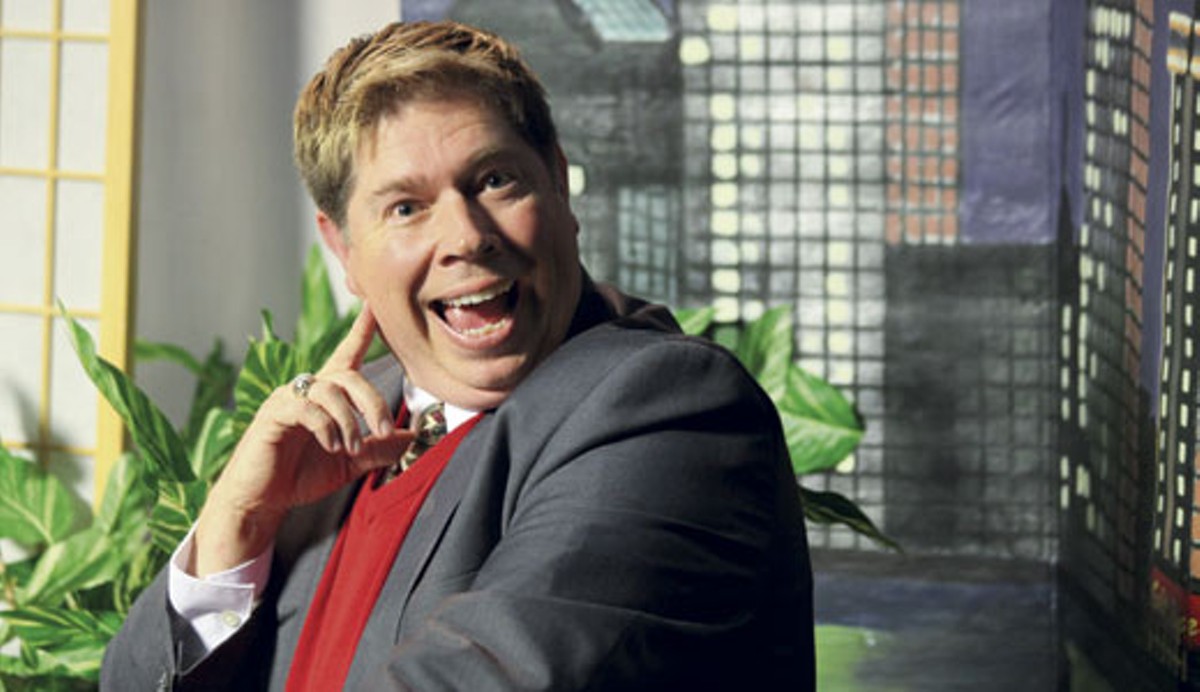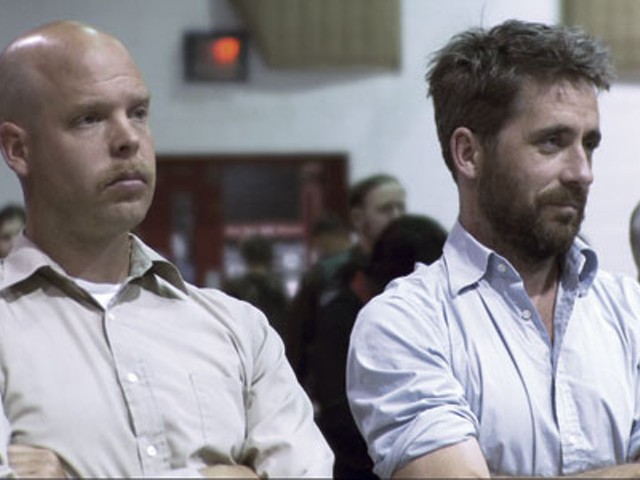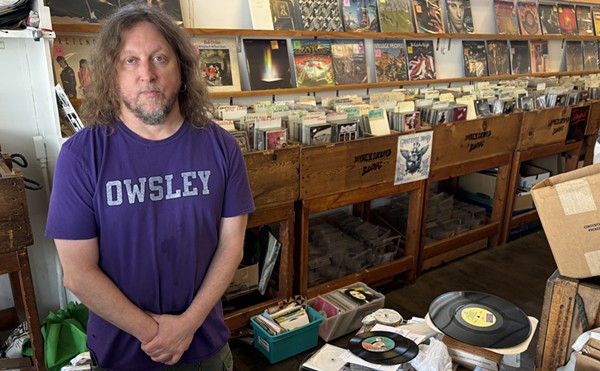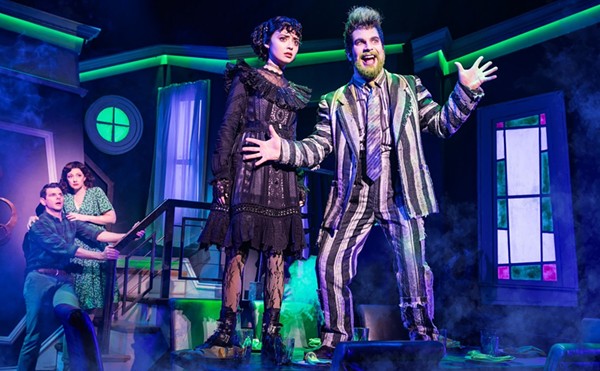Lyle Janes is an odd bird. A boyish man in his early 50s, Janes is the most guileless person you are likely ever to meet. His unwaveringly pleasant demeanor and open-minded optimism are practically supernatural. Any normal person might wonder what’s wrong with him, but that’s just the way he is.
He has boiled down his philosophy of life into the mantra, “It’s nice to be important, but it’s more important to be nice.” He uses this phrase to close every episode of “The Lyle Janes Show,” the public access program that he has been producing for the last 14 years. You can see it on Insight Cable, channel 98, every Wednesday night at 9:30, in the Louisville region.
Janes says his family knew he was destined for show business from an early age. “We had an old player piano, and I used to sing and dance along when the music was playing,” he says. “And when nobody was paying attention to me, I’d say, ‘You’re not paying attention to me!’”
When he was about 10 years old, his parents encouraged him to go to church. The Jehovah’s Witnesses became a big part of his life for most of the next 16 years, but when he got into his 20s, he started to question the church’s positions, and as he explains, “Questioning church policy in the Jehovah’s Witnesses is a no-no.”
Members are required to report any fellow churchgoer who questions the religion in conversation, and it wasn’t long after his 20th birthday that one of the elders in the church came to him and asked, “Have you thought about when God is going to destroy you because you’re so evil?”
“I said, ‘No, I haven’t,’ but, really, it pissed me off!” The concept of Janes being “pissed off” is almost impossible to conceive. How would that work?
Meanwhile, the religion’s various prohibitions — against celebrating birthdays and watching R-rated movies, for instance (he wanted to see “Saturday Night Fever,” dagnabbit!) — helped him move further away from the church until, at the age of 26, he broke away completely.
“It was hard to do,” he says, “because they don’t let you have friends outside of the church, and if you leave the church, you have to leave all of your friends behind.” Fortunately, Janes’ parents weren’t members, and they supported his decision to cut ties with the Jehovah’s Witnesses, which he now refers to as “a cult.”
Before leaving the church, Janes had been treated for depression. “Once I left,” he says, “ I threw away my depression pills, and I wasn’t depressed anymore.”
Freed from the constricting influence of the church, Janes started to explore a number of new opportunities. He tried modeling for a couple years, went to hair design school, and ventured into the world of stand-up comedy, drawing on his experiences with the Jehovah’s Witnesses and as a beauty school student for material.
Recalling those days in an interview on “The Barbara Bryant Show” a couple years ago (currently available on YouTube), Janes said he had seen his share of beauty school disasters. “I ripped a girl’s eyebrow off,” he joked. “She was on her way to her senior dinner dance. She’ll never forget me. I’m really good at eyebrow waxes now. Then there was this time I made this girl’s hair green. I know the color wheel now.”
After finishing beauty school, Janes decided to further explore his long-standing interest in show business and applied to get a cable access show. The waiting list was apparently pretty long; by the time they called him in to do the show, he had practically forgotten he’d even signed up. With typical aplomb and having no idea what he would do with the opportunity, he assured the cable company’s cable access coordinator that he was ready to go into production.
Becky Wills was the supervisor of the public access department when Janes launched his show. His was one of a number of new shows added to the public access line-up in the late ’90s. When Wills took over the department, she recalls that there were as few as 60 shows being produced each month. Toward the end of the decade, however, there were as many as 115. Wills explains that they would keep adding programs, “as long as we had air time and production time.”
The peak lasted less than a year. “People try it and lose interest when they realize how much work it is and drop out,” Wills says.
Lyle Janes was, thus, an exception to the rule in more ways than one. “Lyle and I are about the same age, so we bonded. Most of the public access performers were older women doing religious content,” Wills says, “so I was happy to work with a variety show.”
“I used to think I had the most religion of any person in the city because I had to sit through eight hours of it every day,” she jokes.
And so Janes delivered a welcomed respite.
“Lyle’s show has changed a lot,” according to Wills. “He started out doing skits by himself, singing, in costume. He was a nun one time. Then he was the queen. Another time, he was a cheerleader.”
At this point, Janes was working part-time as a doorman at the Comedy Caravan as well as performing occasionally on stage, and as he got to know the people at the club, he asked the headlining performers to sit down for interviews after their shows. These segments were taped on the stage at the club and, like his remotely recorded skits, delivered to Wills on videocassettes that would be transferred to Super-VHS for airing.
The interview format was closer to his original dream. As a child, Janes had asthma, and he spent a lot of time indoors watching talk shows. His favorite was Merv Griffin. “He would always come on stage and open his jacket and he’d have a different lining every night,” Janes says. “That was when stars looked like stars. They would come out and their hair would be coiffured. Their make-up would be perfect. And I said, one of these days, I want to do what he was doing.”
The comedians were a good match for the show. Tim Wilson, Etta May, Monique, The Rent Daddy, Bernie Lubbers and Mike Armstrong are among the numerous comedians that have appeared, but Janes’ guests have also included local politicians, such as Councilman Tom Owen, and activists, like the late Louis Coleman. More recently, in late 2011, former Miss America Heather French Henry made an appearance, and in December, WAVE 3 Troubleshooter-turned-Saturday morning talk show host Charla Young was Lyle’s guest.
Asked if she had a favorite memory from working with Janes for some 10 years, Wills remembers one particularly sweet episode. “It was his mother’s birthday, and he wanted to do something special for her. She wanted to have high tea, so he hired a bagpipe player.” They had high tea outdoors with a bagpipe serenade.
Like most of the programs produced by Insight’s cable access department, “The Lyle Janes Show” is taped once every four to six weeks. It has a regular, weekly time slot, and every show is repeated in that time slot until the next program is created. Janes’ show is marked by a spontaneity that belies the fact that there isn’t a lot of preparation done before the cameras roll.
The most significant amount of preproduction effort seems to have been expended by Janes’ brother, who painted the city skyline backdrop that stands behind the host’s desk in every episode taped at the Insight studio.
“In the early days,” Janes says, “I thought I’d try to get fancy and have cue cards, but I looked like a used car salesman …” It was obvious he was reading off screen, so now he just “wings it.” There is no editing. The show is taped live and aired “as is.”
(Speaking from personal experience, when I was a guest on the show, promoting my column in LEO among other activities, I remember having a brief exchange with Janes before our segment began. He made a few suggestions regarding what we might talk about, but then, when the cameras were running, he asked about other things completely, apparently satisfied that we had covered those other topics beforehand.)
The program that is airing this month bears evidence of another quirk of the nature of Janes’ “spontaneous” approach. As he explained to Barbara Bryant, “Sometimes when guests don’t show up, you really have to stretch that half hour out. Sometimes you’re grasping for straws, like, ‘What am I going to ask them next?’ And the camera’s still rolling.”
Possibly due to short notice associated with the fact that studio operations were moved from one facility to another over the recent Christmas holiday, one of the guests slated for the current program wasn’t able to make the scheduled studio time. The other guest, comedian Patrick Passafiume, attempted to fill the entire half hour, but after 15 minutes, it was clear he and Janes had run out of steam. Fortunately, Janes has learned from experience and he was ready with a videotape of an earlier program; this month, viewers will be treated to a 12-year-old parody of “The Blair Witch Project.”
Janes is interested in expanding his show and is looking for sponsors. He’d like to move “The Lyle Janes Show” to one of the local commercial channels, but so far he hasn’t found the right deal. With 14 years of experience, he has persistence on his side.
Then again, judging him by his own scale of “being nice,” he is almost certainly the most successful broadcaster in Louisville.
Lyle Janes on YouTube
|
Janes has uploaded two full episodes of “The Lyle Janes Show” to his YouTube channel. The first is a special that was taped on the stage of the Derby Dinner Playhouse in 2007. The guests included the theater’s owner, Bekki Jo Schneider, and two of the company’s actors, Kerry Wiger and Matt Wallace. Typical question: “What’s the craziest thing that ever happened to you on stage?”
|
The other program was taped at the Insight studio in 2009 and features guest Terri Vanessa Coleman, a female impersonator, for the full 30 minutes. In addition to the standard interview, Coleman sings “Summertime” (from “Porgy and Bess”) and opens a gift from Janes. The conversation focuses on the theatrical offerings at Connections. Typical question: “What’s the craziest thing that ever happened to you on stage?” This episode is also noteworthy for the appearance of Janes’ desk, which looks like two pieces of coated cardboard, one laid across the other.
Other videos on Janes’ YouTube channel include an in-depth interview from his appearance on “The Barbara Bryant Show” from late 2011 and a brief appearance on another Insight program, “Northern Kentucky Magazine,” wherein the interviewer describes his show as “fabulous.”
Dig a little deeper and you’ll find Janes’ karaoke performances of “Mack the Knife” and “More.” Merv Griffin and Mike Douglas would be thrilled to know their legacy survives.
So you want to be famous ...
|
While Lyle Janes openly wonders whether the people who watch public access cable do so because they’re bored or just curious, he knows people watch his show.
|
And while he never expects it, strangers recognize him fairly often. On a recent trip to the mall, he heard some people talking about “that guy on television,” and, being a fan of television and always delighted to see famous people in ordinary places, he looked to see who they were referring to.
When he realized they were talking about him, Janes says, “I was a little embarrassed, but I waved.”
If you’d like to be famous like Lyle Janes, all you have to do is contact Insight Communications and ask for a copy of their “Community Access Network Programming Rules & Guidelines.” It’s a 12-page manual that outlines the programmer’s obligations. It’s free to participate, but you have to be an Insight customer, at least 18, and you have to live in an area where channel 98 is available from Insight.
Beyond that, the most important aspects of the arrangement concern sponsorship. Programmers are allowed to make two brief comments regarding sponsors during a 30-minute program, but the sponsorship is limited to actual costs of the production. Otherwise, the content must be non-commercial and must not promote any product or service.
According to the guidelines, the most serious infractions that programmers are likely to commit involve being late for scheduled production dates, failing to show up without calling ahead to cancel, exceeding the five-person limit in the studio, running past the allotted production time, or airing content that violates any FCC rule or community standard.
It’s that easy. Oh, yeah, there’s a waiting period to get an open time slot, but programs are cycled in and out fairly regularly, so it shouldn’t take too long.
For more information, call Insight Communications at 792-1150 or email Kedrick Davis, public access coordinator, at [email protected].






